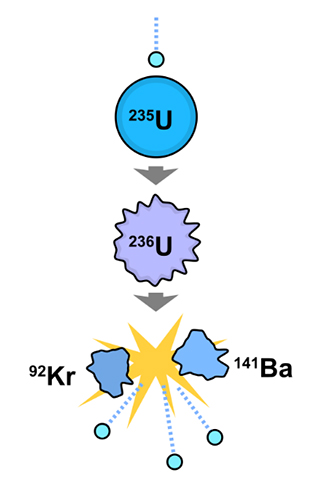Nuclear Fission Reaction in Uranium
Source: Nuclear Fission, Fastfission, Wikimedia Commons |
Nuclear Power Plant Source: Nuclear Power Plant, Felix König, Wikimedia Commons |
|---|
Nuclear Fission Reaction in Uranium
Source: Nuclear Fission, Fastfission, Wikimedia Commons |
Nuclear Power Plant Source: Nuclear Power Plant, Felix König, Wikimedia Commons |
|---|
Fission and fusion are both nuclear reactions that release the energy normally stored in the strong force interaction that holds together protons and neutrons. If there is enough material gathered in one place, both processes can become a self-sustaining chain reaction that will give off very large amounts of energy. When allowed to continue uncontrolled, this chain reaction can lead to a sudden energy release in the form of an explosion.
If, however, the chain reaction is slowed down, then the result is a steady release of energy that can be used to power a generator. In a nuclear power plant, a fission chain reaction is started in a sample of uranium in the core of the reactor. This chain reaction produces heat, which is used to create steam, which in turn powers an electric generator. The chain reaction is controlled with carbon rods that are inserted into the core to absorb the high-energy neutrons that perpetuate the reaction. In the following simulation, you can control the use of these carbon rods and see how the reactor functions.

With current technology, you can control a fission reaction with control rods, but you cannot yet safely control a fusion reaction for generating electricity.
Now let’s take a look at applications of another form of nuclear phenomena, gamma nuclear decay.